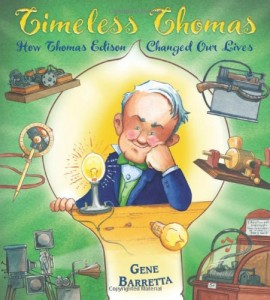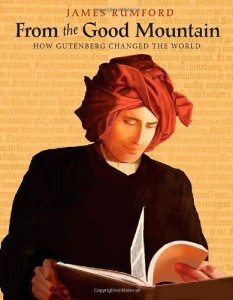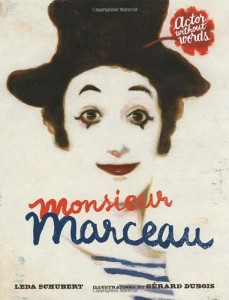Introducing Young Readers to the Lives of Extraordinary Luminaries
By Luisa LaFleur, The Children’s Book Review
Published: May 18, 2013
Biographies of famous people are often huge, all-encompassing tomes of scholarly information. A biography of Albert Einstein would most likely elaborate on the theory of relativity or his most famous equation (E=mc²) which would be well above the understanding of most children. But a recent crop of books aims to introduce the youngest readers to key historical figures while explaining, in simple terms, some of their most stunning achievements. The following are some of the most fascinating we’ve come across.
 On a Beam of Light: A Story of Albert Einstein
On a Beam of Light: A Story of Albert Einstein
by Jennifer Berne; Illustrated by Vladimir Radunsky
Reading level: Ages 6-9
Hardcover: 56 pages
Publisher: Chronicle Books (April 23, 2013)
What to expect: The early life and times of Albert Einstein
In this charming book about Albert Einstein, readers are introduced to a quiet young boy who spends most of his time wondering about life’s larger mysteries. His inquisitive mind questions the way the universe works and our place in it just through his observations of daily life. Einstein’s contributions to modern science have changed the way we understand our world and this book does a wonderful job of sparking a young reader’s interest in this fascinating scientist.
 A Splash of Red: The Life and Art of Horace Pippin
A Splash of Red: The Life and Art of Horace Pippin
by Jen Bryant; Illustrated by Melissa Sweet
Reading level: Ages 5-8
Hardcover: 40 pages
Publisher: Alfred A. Knopf Books for Young Readers (January 8, 2013)
What to expect: Horace Pippin and the obstacles he faced while teaching himself to paint
Born in the late 1800s, Horace Pippin was a strapping young lad with lots of chores and responsibilities. After spending his days piling wood and fetching supplies, Horace would draw pictures of his family or friends or even objects with a piece of charcoal. His love of drawing grew as did his responsibilities. He quit school in the eighth grade to help support his family and after a few years left to fight in the first world war. He was injured and returned home but was unable to find work. Yet the years of hardship didn’t dampen his love of drawing and painting. This inspirational tale helps to put things into perspective and impresses on the reader that no obstacle is too big when you’re following your heart.
 Timeless Thomas: How Thomas Edison Changed Our Lives
Timeless Thomas: How Thomas Edison Changed Our Lives
Reading level: Ages 6-9
Hardcover: 38 pages
Publisher: Henry Holt Books for Young Readers (July 17, 2012)
What to expect: Thomas Edison, the light bulb, numerous other inventions
In Timeless Thomas, we’re introduced to Thomas Edison best known for inventing the light bulb. He began inventing things when he was just a young boy and dedicated his life to improving the world. He started the first research and development company with a large team of scientists, engineers, mechanics and artisans. It was here that he invented the tinfoil phonograph, the predecessor of all our recording devices, and the nickel-iron storage battery, the predecessor to batteries we use today. This book details Edison’s inventions and shows the reader how they are still in use today. A great book for sparking inventive imaginations!
 From the Good Mountain: How Gutenberg Changed the World
From the Good Mountain: How Gutenberg Changed the World
Reading level: Ages 4-8
Hardcover: 38 pages
Publisher: Roaring Brook Press (September 18, 2012)
What to expect: Johannes Gutenberg, the printing press and the invention of movable type
This beautifully illustrated book takes the reader back in time to the 15th century when books were made by hand and painstakingly written and illustrated individually. This arduous process was revolutionized by Johannes Gutenberg, who invented a way to print books with movable type and set the stage for the mass printing of books and other written materials.
 Monsieur Marceau
Monsieur Marceau
by Leda Schubert; Illustrated by Gerard DuBois
Reading level: Ages 4-8
Hardcover: 40 pages
Publisher: Roaring Brook Press (September 4, 2012)
What to expect: The world’s most famous mime, Marcel Marceau. Some references to World War II that may be difficult to explain to younger readers
This book introduces young readers to Marcel Marceau, the world’s most famous mime. He was able to transmit to his audiences incredible acts–without speaking. He could climb imaginary stairs or tame a lion or play an instrument, all with just his facial expressions and his body. His extraordinary talent was borne of a life of struggle and hardship, particularly during World War II and the loss of his father in a concentration camp. Although this book touches on the atrocities of war, it is ultimately an uplifting story about the life of an extraordinary entertainer.

